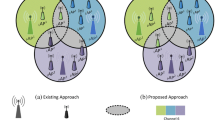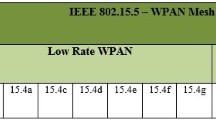Abstract
Wireless USB (WUSB) is the USB technology merged with WiMedia PHY /MAC. WUSB can be applied to wireless personal area network applications as well as PAN applications like wired USB. However, due to mobility of WUSB devices in multi-hop environment, DRP (distributed reservation protocol) reservation conflicts happen frequently among WUSB devices with three-hop distance. To solve this problem in large scale WUSB networks, we propose a new DRP reservation scheme using dual role devices and a new Operation Info bits for three-hop mobility support. It is shown by simulation and numerical results that throughputs of WUSB devices at three-hop range hidden DRP reservation conflicts are largely increased.
Similar content being viewed by others
Abbreviations
- UWB:
-
Ultra wide-band
- D-MAC:
-
Distributed medium access control
- DRP:
-
Distributed reservation protocol
- WPAN:
-
Wireless personal area network
- WUSB:
-
Wireless universal serial bus
- MMC:
-
Micro-scheduled management command
References
WiMedia MAC Release Spec. 1.5. (2009). Distributed medium access control (MAC) for wireless networks. October 5, 2009. http://www.wimedia.org/en/index/asp.
Certified wireless USB from the USB-IF. http://www.usb.org/developers/wusb/.
Wang, J., Liu, X., & Wang, X. (2011). Conflict-free transmission schedule based on network coding in wireless networks. In Third international conference on communications and mobile computing (pp. 328–331).
Jiang, Y., Tian, J., Chen, H., & Hu, H. (2001). Cyclostationarity-based decision reporting scheme for cooperative spectrum sensing. Wireless Personal Communications.
Halunga S. V., Vizireanu D. N. (2010) Performance evaluation for conventional and MMSE multiuser detection algorithms in imperfect reception conditions. Digital Signal Processing 20(1): 166–178
Halunga S. V., Vizireanu D. N., Fratu O. (2010) Imperfect cross-correlation and amplitude balance effects on conventional multiuser decoder with turbo encoding. Digital Signal Processing 20(1): 191–200
Feng, G., Liew, S., & Fan, P. (2008). Minimizing interferences in wireless ad hoc networks through topology control. In Proceedings of ICC08 (pp. 2332–2336). May 19–23, 2008.
Shih K.-P., Chen Y.-D., Chang C.-C. (2011) A physical/virtual carrier-sense-based power control MAC protocol for collision avoidance in wireless ad hoc networks. IEEE Transactions on Parallel and Distributed Systems 22(2): 193–207
Mi, Z., & Yang, Y. (2011). Topology control and coverage enhancement of dynamic networks based on the controllable movement of mobile agents. In Proceedings of 2011 IEEE international conference on communication, Kyoto, June 2011.
Wang F., Li D., Zhao Y. (2011) On analysis of the contention access period of IEEE 802.15.4 MAC and its improvement. Wireless Personal Communications 65(4): 955–975
Kim J.-W., Hur K., Park J., Eom D.-S. (2009) A distributed MAC design for data collision-free wireless USB home networks. IEEE Transaction on Consumer Electronics 55(3): 1337–1343
USB-IF. http://www.usb.org/home/.
High Rate Ultra Wideband PHY and MAC Standard 1st edn, December, 2005. http://www.wimedia.org/en/index.asp.
Alliance, WiMedia. http://www.wimedia.org.
Jun, J., Peddabachagari, P., & Sichitiu, M. (2003). Theoretical maximum throughput of IEEE 802.11 and its applications. In 2nd IEEE international symposium on network computing and applications (pp. 246–256). April 16–18, 2003.
Zang, Y., Hiertz, G. R., Habetha, J., Otal, B., Sirin, H., & Reumerman, H.-J. (2005). Towards high speed wireless personal area network—efficiency analysis of MBOA MAC. In Proceedings of international workshop on wireless ad-hoc network 2005 (pp. 10–20). May 23–26, 2005.
Peng, F., Peng, B., & Leung, V. C. M. (2011). An application oriented power saving MAC protocol for wireless sensor networks. Wireless Personal Communications.
Kim K.-I. (2012) Adjusting transmission power for real-time communications in wireless sensor networks. Journal of Information and Communication Convergence Engineering 10(1): 21–26
Author information
Authors and Affiliations
Corresponding author
Rights and permissions
About this article
Cite this article
Kim, JW., Hur, K. & Lee, SR. Wireless USB Cluster Tree based on Distributed Reservation Protocol for Mobility Support. Wireless Pers Commun 71, 275–298 (2013). https://doi.org/10.1007/s11277-012-0815-z
Published:
Issue Date:
DOI: https://doi.org/10.1007/s11277-012-0815-z




